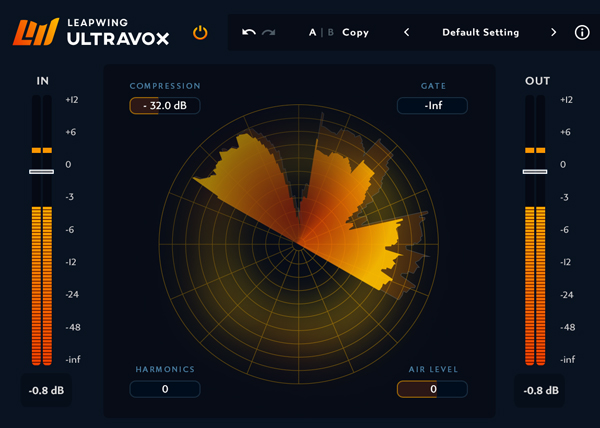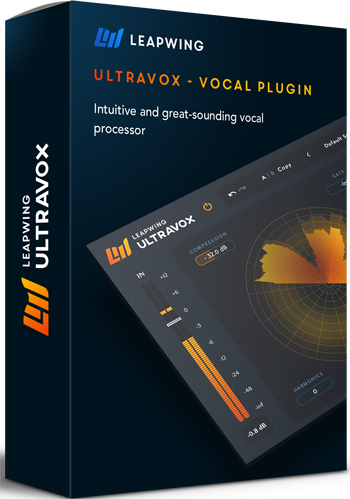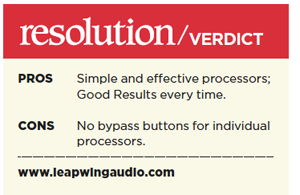

 |

|
 |
| Leapwing UltraVox |
Named after a mid-70s British new wave rock band, Leapwing's Ultravox is a vocal processor plugin--a complete, all-in-one processing chain for recording or mixing vocals. Its four, simple controls belie the care, expertise and time used 'under the hood' developing, refining and testing this marvelous plugin. This craftsmanship was evident the first time I used it in a mix. The goal is better sounding vocals for everyone no matter their recording engineering skill level. A good singer, great performance, a good (enough) microphone, and UltraVox are all you need.
For recording, latency is low with 144 samples late in Pro Tools 2021.10 HDX Ultimate at 48kHz. It runs 64-bit and supports up to 384kHz (DXD) and in VST, VST3, AAX, and AU hosts/formats--macOS 10.13 or higher and Win 8 and 10 PCs.
Fantastic Four
The top section of the resizable UltraVox interface has a familiar frame with a Bypass button that, while bypassed, retains its latency, an Undo/Redo button, and A|B Comparison to quickly store two different settings. When recording, I used A|B to toggle between separate settings for quiet verses and loud choruses. There is a drop-down menu of 12 presets you can modify and then save to augment your own preset collection.
The four processors are named: Compression, Harmonics, Air, and Gate. They each have a single slider control located at the four corners of the GUI. These are four well-tuned algorithms that interact with each other to avoid attack/release time settings conflicts between the compressor and gate.
At the center of the GUI is a circular 'radar screen' that sweeps clockwise; it's an instantaneous histogram display that shows varying output level and the amount of gain reduction in a darker color (if you have compression enabled) over about 25 seconds. I liked how the display fades out when there is no audio.
 |
| Leapwing UltraVox Box |
For the entire review, I imported into Pro Tools Ultimate HDX a dozen lead vocal tracks from different mix projects with lots of different styles of songs, It is a good assortment of artist--male, female, shouters, whisperers, rappers, great singers, and not great singers.
Vocal Compressor
UltraVox uses a single band compressor with a program-dependent short attack time of less than 2ms and a long release time typically over 0.5 seconds. The single control sets threshold from -60dB to 0dB and there is automatic makeup gain.
I tried the compressor on a female Country singer's lead vocal. I was looking for a super clean sound and with the compressor at -17dB threshold, I got a straight-ahead traditional vocal sound. The makeup gain worked well unless you crank the Threshold. I tried lowering the Input level fader and then turned Threshold down to about -34dB and raised the output level to match. I used the A|B function to compare both setups. It is a different compressor sound for sure but the Gate section doesn't work as accurately. Since you cannot individually bypass any of the four processors, A|B is a way to compare two presets with and without one or more of the processors in/out.
Vocal Gate
The UltraVox Gate is designed to reduce background room tone and, to a certain extent, inhalations and mouth noises that are especially hearable with close-miked vocals. Gate is actually a downward expander with a variable program-dependent medium long attack and short release times.
For testing just the Gate, I tried it on female Rock singer's track for her verses where she sang at the bottom of her range and at a low level right up close to the mic. I started with the "Pop Vocal Gentle" preset and adjusted it to suit. It worked great and never clipped off the front of words or closed down too early. There was a little room tone and leakage from her headphones and, with max compression, it is still heard but greatly reduced.
Air And Harmonics Are Like Icing On the Cake
Air is a 12kHz shelving EQ with a "custom curve to add crispness without harshness" You may boost or cut with this control. (Option-click any control returns it to 0, its default preset value.)

|
Air is useful in two ways: restore lost high frequencies from deep compression (+ values) and also to reduce brightness (- values). Although not a de-esser, Air is subtle and always used in my UltraVox settings. If your singer doesn't have an "S" problem, Air always sounds great. I found it very useful for mixing when just a touch of Air made such a big difference by opening up the sound of a lead vocal.
Harmonics generates 2nd and 3rd harmonics and blends them back with the original using its wet/dry control. I tried Harmonics on all my lead vocal examples. My stand out use of UltraVox was for a Rock/Country song with a male singer. I started with the "Rock Vocal Hard" preset that uses all four processors--notably Harmonics set to 95. Again I used A|B to assess the effect of the Harmonics and I loved it. It seems made for this singer giving him just the right amount of grit and edge you cannot get with an EQ.
Leapwing's UltraVox is an easy-to-use plugin so well thought out in its design, you cannot help but like and use it as I do! Highly recommended!
|
|
|